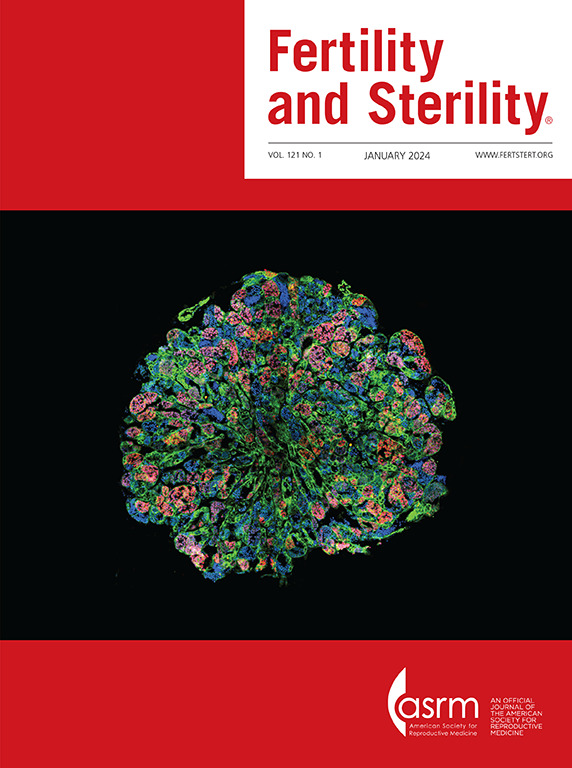超声引导下宫腔镜下宫腔抽空术治疗漏产
IF 6.6
1区 医学
Q1 OBSTETRICS & GYNECOLOGY
引用次数: 0
摘要
本文章由计算机程序翻译,如有差异,请以英文原文为准。
Ultrasound-guided hysteroscopic uterine evacuation in cases of missed abortion
Objective
To describe the hysteroscopic, ultrasound-guided removal of missed abortion products of conception, emphasizing identification and resection of the different layers, visualization of the embryo and yolk sac, and maternal contamination-free direct sampling of the embryo and trophoblast.
Design
Illustration of a step-by-step innovative ultrasound-guided surgical technique for uterine evacuation during optically directed embryo and trophoblast biopsy.
Subjects
Women with missed abortion, with or without a history of infertility or recurrent pregnancy loss. The 7 patients included in this video gave consent for publication of the video and posting of the video online including social media, the journal website, and scientific literature websites.
Exposure
Missed abortion was diagnosed by transvaginal ultrasound confirming loss of fetal heartbeat. After informed consent, the patient was brought to the operating room. Under deep sedation, a 5-mm hysteroscope was inserted transcervically, and the uterine cavity was distended with normal saline (80–100 mm Hg). The implantation site was identified by direct visualization and transabdominal ultrasound. The gestational sac was opened with hysteroscopic scissors, and the extracoelomic cavity was entered. The yolk sac and embryo were visualized and evaluated. Embryo and chorionic villi sampling were performed with hysteroscopic forceps. After removal of the embryo, resection of the gestational sac was accomplished with hysteroscopic forceps and scissors.
Main Outcome Measures
Step-by-step educational video.
Results
Optically identified embryonic and trophoblastic tissue and the corresponding cytogenetic result were obtained in all cases, without maternal cell contamination. There were no intraoperative complications. Patients’ follow-up revealed no cases of retained products of conception or intrauterine adhesions. All patients who attempted pregnancy were successful, without complications.
Conclusion
Ultrasound-guided hysteroscopic removal of a missed abortion is noninvasive and potentially safer than conventional surgical techniques. It allows comparison of trophoblastic vs. embryo biopsy and resolution of, for example, mosaicism in placental pole preimplantation embryo biopsies. A potential disadvantage is the relative complexity of the procedure compared with routine dilation and curettage (1–5).
Evacuación uterina histeroscópica guiada por ultrasonido en casos de aborto no deseado.
Objetivo
Describir la extracción histeroscópica, guiada por ultrasonido de los productos de aborto, haciendo hincapié en la identificación y resección de las diferentes capas, la visualización del embrión y el saco vitelino y la toma de muestras directas del embrión y el trofoblasto sin contaminación materna.
Diseño
Ilustración de una innovadora técnica quirúrgica guiada por ultrasonido paso a paso para la evacuación uterina durante la biopsia de embriones y trofoblastos dirigida ópticamente.
Sujetos
Mujeres con aborto retenido, con o sin antecedentes de infertilidad o pérdida recurrente del embarazo. Los 7 pacientes incluidos en este video dieron su consentimiento para la publicación del video y la publicación del video en línea, incluidas las redes sociales, el sitio web de la revista y los sitios web de literatura científica.
Exposición
El aborto precoz se diagnosticó mediante ecografía transvaginal que confirmó la pérdida del latido fetal. Tras el consentimiento informado, el paciente fue llevado al quirófano. Bajo sedación profunda, se insertó un histeroscopio de 5 mm por vía transcervical y se distendió la cavidad uterina con solución salina normal (80-100 mm Hg). El sitio de implantación se identificó mediante visualización directa y ecografía transabdominal. Se abrió el saco gestacional con tijeras histeroscópicas y se introdujo en la cavidad extracelómica. Se. visualizó y evaluó el saco vitelino y el embrión. La toma de muestras de embriones y vellosidades coriónicas se realizó con pinzas histeroscópicas. Después de la extracción del embrión, la resección del saco gestacional se realizó con pinzas histeroscópicas y tijeras.
Principales medidas de resultados
Video educativo paso a paso.
Resultados
En todos los casos se obtuvo tejido embrionario y trofoblástico identificado ópticamente y el resultado citogenético correspondiente, sin contaminación de células maternas. No hubo complicaciones intraoperatorias. El seguimiento de las pacientes no reveló casos de productos retenidos de la concepción o adherencias intrauterinas. Todas las pacientes que intentaron embarazo fueron exitosas, sin complicaciones.
Conclusión
La extirpación histeroscópica guiada por ultrasonido de un aborto no deseado es no invasiva y potencialmente más segura que las técnicas quirúrgicas convencionales. Permite la comparación de la biopsia trofoblástica frente a la biopsia embrionaria y la resolución de, por ejemplo, mosaicismo en biopsias de polos placentarios en embriones preimplantacionales. Una posible desventaja es la complejidad relativa del procedimiento en comparación con la dilatación y el legrado de rutina.
求助全文
通过发布文献求助,成功后即可免费获取论文全文。
去求助
来源期刊

Fertility and sterility
医学-妇产科学
CiteScore
11.30
自引率
6.00%
发文量
1446
审稿时长
31 days
期刊介绍:
Fertility and Sterility® is an international journal for obstetricians, gynecologists, reproductive endocrinologists, urologists, basic scientists and others who treat and investigate problems of infertility and human reproductive disorders. The journal publishes juried original scientific articles in clinical and laboratory research relevant to reproductive endocrinology, urology, andrology, physiology, immunology, genetics, contraception, and menopause. Fertility and Sterility® encourages and supports meaningful basic and clinical research, and facilitates and promotes excellence in professional education, in the field of reproductive medicine.
 求助内容:
求助内容: 应助结果提醒方式:
应助结果提醒方式:


